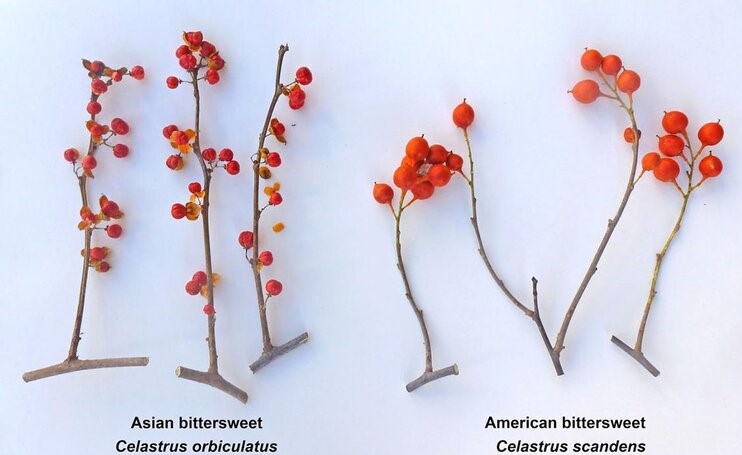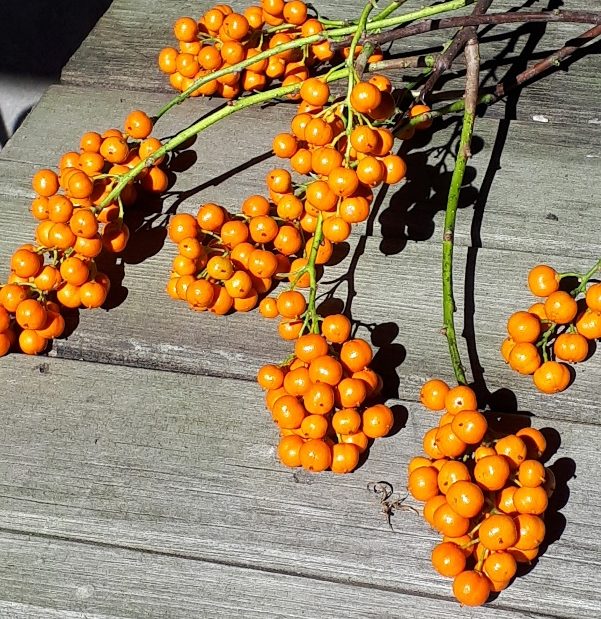The Bittersweet Season of Autumn
Is there a more perfect plant than the American Bittersweet (Celastrus scandens) to symbolize autumn?
This native North American vine spends the growing season twining its way through branches of trees and shrubs and along fences until it can bring its bright orange covered berries into the warm sunlight of fall. As with many beauties it can be overtaken by its aggressive cousin Asian Bittersweet (Celastrus orbiculatus) that grows faster and sends out more fruit and can damage garden plants and forests. But with any lookalikes there are subtle differences. The North American variety has larger clumps of berries gathered at the end of the stems rather than along the stalk.

MN Department of Agriculture photo demonstrates the difference between Asian (left) and American Bittersweet.
The facts about American Bittersweet:
It is dioecious, meaning they are either male or female. And you need at least one of both genders to produce berries on the female vines, unfortunately they are difficult to identify until they produce berries, so buying from a breeder or planting many seeds or taking cutting from mature plants are the only ways to ensure success.
The vines will grow 20 to 30 feet (6 to10 m.) with very small green flowers. They produce fruit (which is toxic to humans but birds love them) from September to November. The berries are covered with a stiff orange capsule that splits open to reveal a bright red berry.
Many people cut the vines in the fall and use the vines and berries in arrangements and wreaths. The stems will hold the berries as they dry and maintain their beauty indoors throughout the season. They can also be used outdoors in fall and winter arrangements.
How the Grow Bittersweet:
You can grow bittersweet from cuttings but we will focus on growing from seed. If you choose to grow from the berries in your bouquet, you can let the berries dry on the branches (or on a paper towel) and when they are dry, in at least 3 weeks (or more if you wish to enjoy your bouquet longer) remove the inner seeds from the dried flesh and let them dry on a paper towel for a week.
The seeds need to be cold stratified (simulating winter) to germinate. Sow the seeds in a plastic resealable bag in a light covering of moistened potting soil mix or peat moss. Place it in a refrigerator (NOT freezer) for three months. After three months, the seeds should be starting to germinate, sow them in a container with a light covering of soil. Keep the soil moist, not weed and in a warm sunny window. Your seedlings should be ready to transplant outdoors after the danger of frost has passed.
Provide your vines with a sturdy trellis or fence to grow on. They are twining vines without tendrils so they need a structure they can wind around. Make sure the mature vine will be far enough away from buildings so that there is adequate air flow as they can suffer from powdery mildew.
Bittersweet produces berries on new wood, so pruning it back to cut berries or to remove dead or damaged branches will create a healthier plant and more berries. If necessary, the vine can be cut back to ground level and it will send out new shoots. Be careful if harvesting in natural areas as over harvesting has led to a decline in the native species. (Always have permission if not harvesting on your own property).
I hope you enjoy this native beauty.
October 2021
Susanne Susanne

